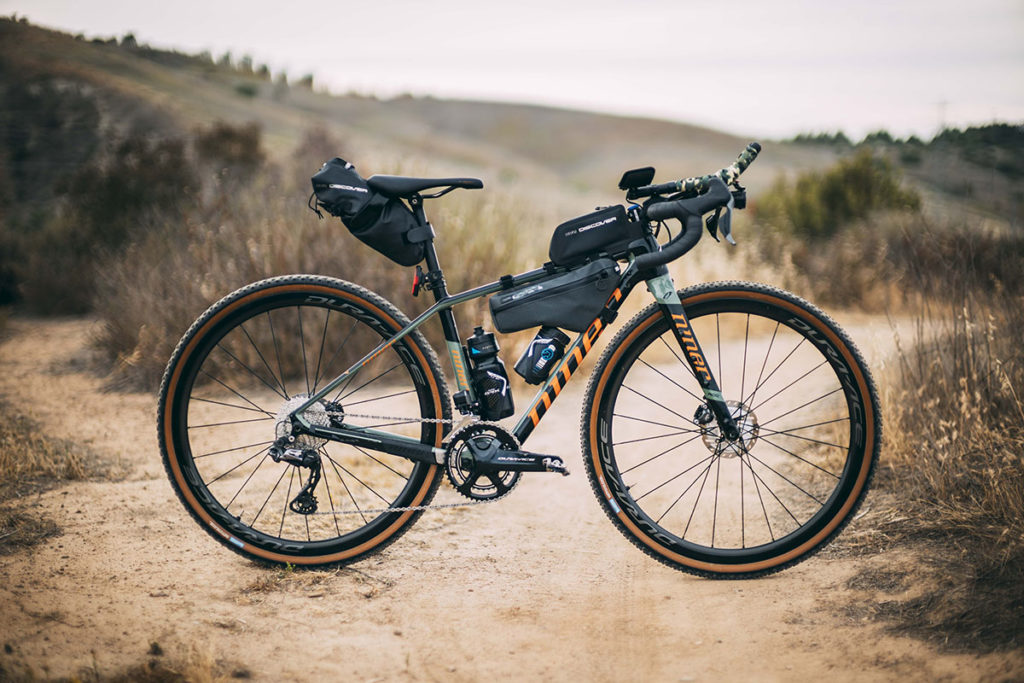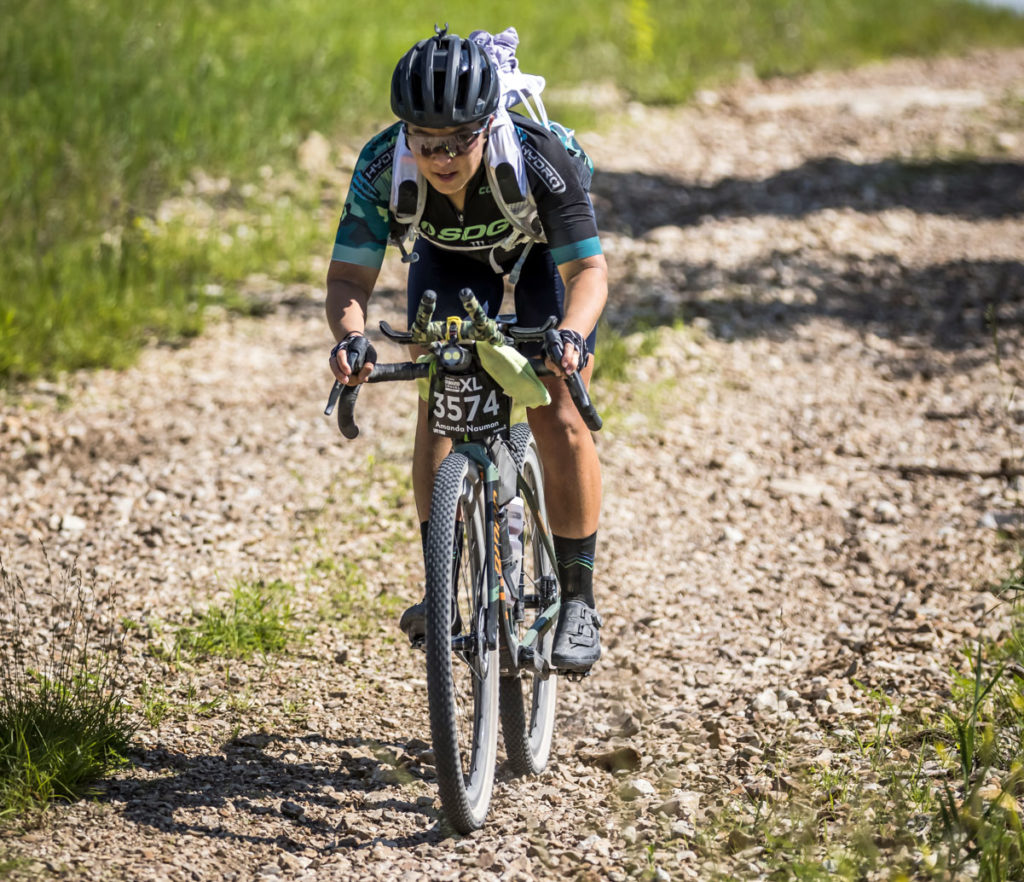Amanda Nauman: Racing Unbound XL
Amanda Nauman is a true inspiration: Not only is she a top-tier cyclocross and gravel racer, but she also works full-time as an engineer – and she’s putting together a gravel event, Mammoth Tuff, that takes riders into the beautiful eastern Sierra Nevada. We caught up with her after her epic second place in the 350-mile Unbound XL.
JH: Congratulations! Second place in Unbound XL is amazing, especially considering that your true specialty are 60-minute cyclocross races – although you’ve also won the 200-mile Unbound twice, so you’re no stranger to long distances. Is it true that this is the first time you rode for more than 24 hours?
AN: Thank you! It is true that this is the first time I rode for more than 24 hours in one go! A couple weeks before this event I completed the southern Caldera 150 route out of Mammoth Lakes. It had a total elapsed time of 38:31:55, but I stopped and made camp for about 9.5 hours of that. I was pedaling for 17.5 hours on the second day and thought it was the hardest thing I had ever done – until I pedaled into Emporia on the evening of June 5th. Then that became the hardest thing I had ever done on the bike!

JH: Tell us a bit about the race!
AN: It was definitely a race from the get-go! Once we got to the gravel, the front guys really started to turn the screws and drive up the pace. I was truly racing for the first 6.5 hours of the event until dark. That’s when I had to stop and tinker with my lights, and Lael [Wilcox] rode off into the darkness, and I never saw her again. From there I settled into my own pace. Unfortunately, I was solo for about 21 of the 29 hours, which was not intentional and not ideal. I spent a lot of time listening to Harry Potter, cursing the headwinds, and dreaming of Mountain Dew slushies.
In a weird way I enjoyed the solitude. So much of the event is being bombarded with friends and fans and social interaction that I crave the solitude just as much. It was nice to simply be out there, and I fully recognize that it’s a privilege to go and pedal my bike with nothing else to worry about. That’s what I enjoy the most. Fighting drowsiness, searching for motivation during 21+ hours alone, organizing gear, battling headwinds, and riding in the dark were all new challenges for me. While racing a 200-mile event is certainly hard, merely surviving through and finishing the 350 was harder. It was a great test that got me outside my comfort zone!

JH: This year was your sixth time racing in Kansas… What does Unbound represent for you? Why are you coming back year after year?
AN: My favorite race, that I look forward to the most every year, is Unbound, the race formerly known as Dirty Kanza. The town and the people hold a special place in my heart, and it’s an event that shaped a lot of my cycling career. It represents freedom and community for me. I come back year after year because I want to create new memories with my friends and simultaneously challenge myself. Some years that’s with a goal to win, some years that’s with a goal to get in the 1,000 Mile Club, and some years that’s with a goal to stay alive for 350 miles. Next year, they should be changing the 200 route (they do this every two years), so I’m still debating if I want to come back in 2022 to better my 350 effort or tackle a new 200 route. It’s always something different always something fun to experience.
JH: How do you train for events like these?
AN: Because I race cyclocross, my year of training is split between the longer gravel and mountain bike events and the shorter, punchier efforts required for ‘cross. I’ve always enjoyed splitting my time this way and changing things up part-way through summer. Specifically for Unbound XL, the training hasn’t been all too different than my training for the 200. With a regular desk job, it’s not like I have more time to train just because I’m entering a longer event. I have the same amount of time, so I needed to get creative. Where I would’ve done more group rides and focused on higher-intensity work for the high speeds early in the 200, this year, I’ve spent that time in other areas. I shifted my training towards learning experiences balanced with intervals instead of a focus on pure fitness, if that makes sense. It’s been new for me, and I’ve already come away from the experience with changes I could make for next time.

JH: Tell us about your equipment. You rode what looks like a pretty standard gravel bike…
AN: It’s a Niner RLT 9 RDO with Shimano GRX, a Dura-Ace power meter, Dura-Ace wheels, with PRO Components and bags. I would agree it’s pretty standard other than the fact that it has aero bars. Normally I would be against using aero bars in a mass-start event like the 200-mile distance, but the 350 is unique in that it’s so spread out and riders need as many different hand positions as possible. My swimmer shoulders were happy to have the TT position!
JH: How about the shifting? Why do you choose electronic shifting over cable-operated shifters? And why a double crankset instead of a One-By? What gear ratios?
AN: Electronic shifting is one of those things that you don’t know you need until you’ve tried it. I recognize it’s a privilege to have electronic shifting and so many Di2 options for my bikes, but I fully endorse it for its intended purpose. The functionality, interchangeability, and ease of use will make you wonder why you didn’t switch to Di2 sooner. At least it did for me!
Both the 1x and 2x setups are great for their desired applications. I use 1x for cyclocross racing and 2x for longer gravel events. In the shorter races, it’s better for me to limit my gear choices and simplify the setup. In longer events, I appreciate having a better gear range and smaller jumps on the cassette between gears. For XL, I ran a 46-34T up front and an 11-40 XTR cassette in the back. I brought an 11-34 cassette, but decided that with the number of climbs I’d do in 24+ hours, I would need to be able to spin as much as possible.

JH: Now the thing everybody wonders about: Tires. You ran 48 mm Oracle Ridge knobbies, when most riders were on narrower tires in the 40-45 mm range. Why did you go wider?
AN: Comfort. I honestly thought I would run the 700×42 Hurricane Ridge in the Endurance Plus casing, based on how much it had been raining in the couple weeks leading up to the event week. But after riding on Tuesday and Wednesday around Emporia and hearing reports from out on the course, I opted for the 48s. The wind and sun would dry out whatever was left of the precipitation, so the 48s made sense from a comfort standpoint. I also listened to the podcast you did with Craig Dalton and have since been persuaded to ride wider and lower whenever possible!

JH: How do you choose your tires for an event – not just Unbound, but any gravel race?
AN: Because of my cyclocross background, I nerd out on tire selection way more than the average rider. I’m very well-versed in the famous gravel events and know what works and what doesn’t based on different terrain. I would say choosing is a combination of experience, brainstorming with my partner David [Sheek], picking from what I have, and the weather forecast.
JH: What tire pressure did you run at Unbound?
AN: 29 psi front, 31 psi rear [2.0 / 2.1 bar]. If I had done the 200-mile race with less gear and less overall weight, I would’ve run a lower pressure. I went a tad higher than normal because of the extra weight and because I assumed the tires might lose a little air over 24+ hours.
JH: Did you have any tire trouble?
AN: No tire trouble! I hit one mud section where my bike collected a lot of mud for a few yards, but I was able to get rolling pretty quickly afterwards. Luckily that was the only mud section, or else my tire choice would have slowed me way down. It’s a riskier choice for me because the spacing to the chainstays on my tiny frame is slim. I think I’m pretty good at line choice, bike handling, and knowing what to expect in the Flint Hills, so I’m pleased with no tire trouble.

JH: What are your plans going forward? Any exciting projects coming up?
AN: The rest of my summer is quite wide open. I put a huge emphasis on Unbound XL and tackling the Caldera 500 later this season. With pandemic uncertainty, I was hesitant to do any significant planning, but now it seems we’re back to a sense of normalcy… I’ll plan a few more gravel events before the cyclocross season this winter. Before that, Mammoth Tuff (above) is certainly taking center stage in the immediate future!
JH: Now that you’ve got a taste of ultra-distance racing, is this something you might be tempted to pursue more? Will we see you in the Silk Road Mountain Race or the Tour Divide some day?
AN: I don’t know. I’m surely tempted, but I’m also fully aware of the time commitment and what it takes to step away from my regular job for a chunk of time. The first thing I lamented to a couple friends after the Caldera 150 was how in the world folks do that over the course of several weeks when I felt like I could barely survive two days. Ask me if I’ll do the Silk Road Mountain Race after the Caldera 500. That’s the one I’m mighty enamored by, but I’m afraid Caldera will scare me away from any sort of ultra in the future! In all seriousness, I have a huge respect for everyone who tackles the ultra distances, and I wish I had more time to dedicate to such grand endeavors.

JH: What would you tell somebody who’s thinking about entering their first gravel event?
AN: Have fun! The key word here is it’s an ‘event’ and not a race. It can be whatever you want it to be, and it doesn’t have to be a race if you don’t want it to be. Remember to do your homework. It’s no secret that going to these gravel or endurance events requires a lot of investment in time and money. You’re making these sacrifices for a long, fun day on the bike, so you owe it to yourself to make it as easy and stress-free as possible. Put together simple training goals, do skills work, find a nutrition and hydration strategy that works, and get to the starting line with peace of mind that you’ve done the best you can to prepare.
Further Readering:
• More about Mammoth Tuff, Amanda and Dave’s big gravel event in September 2021.
Photo credits: Jason Ebberts (Photos 1, 5, 8); Nick Nelson (Photos 2, 6); Kevin Fickling/Shimano (Photo 3, 4).



